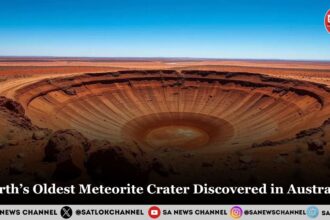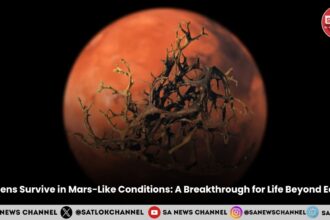For centuries, humanity has gazed at the crimson speck in our night sky and asked a profound question: are we alone? Mars, our planetary neighbour, has long been the focal point of this cosmic inquiry, a world of rusted dust and silent craters that hold the tantalizing possibility of a second genesis. Now, in the dried-out river delta of Jezero Crater, NASA’s Perseverance rover has uncovered evidence that may bring us closer to an answer than ever before.
A recent study, spearheaded by researchers analyzing data from the rover, has identified a potential biosignature, a chemical fingerprint that is difficult to explain without the intervention of life. While this is not yet definitive proof, it represents the most compelling clue to date in the decades-long search for life beyond Earth. This discovery, centered on peculiar mineral patterns in a rock nicknamed “Chayava Falls,” forces us to re-evaluate the history of Mars and consider the staggering implications if life once thrived there. To understand the weight of this moment, we must first trace the long, winding path of our quest: a story of fleeting hopes, rigorous skepticism, and the relentless pursuit of scientific truth.
A History of Hope and Scrutiny
Our search for Martian life did not begin with rovers; it started with telescopes and imaginations, most famously with Percival Lowell’s late 19th-century observations of what he believed were intricate “canals,” evidence of a dying civilization. While these turned out to be optical illusions, they cemented Mars in our collective consciousness as a potential abode for life.
The robotic age brought us a more direct approach. In the 1970s, NASA’s Viking 1 and 2 landers became the first spacecraft to operate on the Martian surface. They were equipped with miniature biology labs designed to detect active, present-day life. In one experiment, Martian soil was mixed with water and nutrients. The initial result was a shock: gases were released, a potential sign of metabolism.
The world held its breath. However, subsequent experiments failed to find any organic molecules, and scientists eventually concluded that the gas release was likely caused by unusual, non-biological chemical reactions in the reactive Martian soil. The verdict shifted from a tentative “yes” to a probable “no.” The Viking missions taught a crucial lesson: extraordinary claims require extraordinary, and thoroughly cross-examined, evidence.
Decades later, in 1996, the focus shifted from present life to ancient fossils. A meteorite discovered in Antarctica, designated ALH84001, was identified as a rock blasted from Mars millions of years ago. Under an electron microscope, scientists saw tiny, segmented structures that looked remarkably like fossilized bacteria. The news was electric. Yet again, skepticism and scientific rigour tempered the excitement. Critics argued that similar shapes could be formed through purely geological processes. Today, the evidence from ALH84001 remains in limbo, a tantalizing “maybe” that has neither been confirmed nor entirely debunked.
These early efforts, along with discoveries by later missions like the Curiosity rover, which confirmed the presence of organic molecules (carbon-based compounds, not necessarily from life) and vast evidence of ancient rivers and lakes, set the stage for Perseverance. Scientists knew that if life ever existed on Mars, the best place to find its preserved remnants would be in a location that once held water for a prolonged period. They chose Jezero Crater, the site of a former lake fed by a sprawling river delta billions of years ago.
The Discovery at “Chayava Falls”
Landed in 2021, the Perseverance rover is the most advanced astrobiology laboratory ever sent to another world. Its mission: to seek signs of ancient life and collect rock samples for a future return mission to Earth. While exploring the ancient mudstone of the river delta, the rover’s instruments homed in on a rock with unusual patches that scientists dubbed “leopard spots.”
These spots were more than just a visual curiosity. Using its suite of analytical tools, Perseverance found that the spots were rich in two specific iron- and sulfur-based minerals: vivianite and greigite. Crucially, these minerals were co-located with organic molecules.
This combination is what makes the discovery so electrifying. On Earth, vivianite and greigite are frequently associated with microbial life. They are often the byproducts of a process called chemosynthesis, where microbes derive energy not from sunlight (like photosynthesis) but from chemical reactions. In this scenario, ancient Martian microbes could have “fed” on the energy released by reducing iron and sulfur compounds in the mud, leaving behind vivianite and greigite as their metabolic waste, what some scientists have colorfully described as “microbial poop.”
Of course, the science team had to rule out other possibilities. Could these minerals have formed under intense heat? The surrounding geology and chemistry of the rock strongly indicate a low-temperature environment. Could they have formed in a highly acidic setting? Again, the evidence from the rock points away from this explanation. After methodically eliminating the most obvious non-biological pathways, the biological explanation remains the most compelling, though unproven, hypothesis. As detailed in the scientific journal Nature by a team led by Joel Hurowitz of Stony Brook University, the find at Chayava Falls stands as a powerful potential biosignature.
The Path to Certainty: Bringing Mars to Earth
As history has shown, a single piece of evidence, no matter how compelling, is not enough. To move from “potential biosignature” to “definitive proof of life,” the samples collected by Perseverance must be studied in laboratories on Earth with instruments far more powerful and sophisticated than what can be fitted onto a rover. This is the goal of the ambitious Mars Sample Return (MSR) mission.
Perseverance has been drilling rock cores, sealing them in ultra-clean titanium tubes, and depositing them on the Martian surface to be picked up by a future mission. Though the MSR mission is a complex, multi-stage endeavor, currently facing budgetary and scheduling challenges, it is the only way to get the answers we seek. Once these precious samples are back on Earth, scientists will perform a series of definitive tests.
- Isotopic Fractionation: This is considered the gold standard for identifying biological processes. Carbon exists in different forms, or isotopes, primarily the lighter Carbon-12 and the heavier Carbon-13. Life on Earth shows a distinct preference for the lighter Carbon-12. When microbes consume carbon, their metabolic processes incorporate C-12 more readily than C-13. If scientists find that the organic matter in the Martian samples is significantly “enriched” in Carbon-12 compared to the surrounding non-organic carbon, it would be a smoking gun for life.
- Amino Acid Chirality: Many organic molecules, including the amino acids that form proteins, exist in two mirror-image forms, like a left hand and a right hand. Non-biological processes create a roughly 50/50 mix of left- and right-handed versions. Life on Earth, however, exclusively uses left-handed amino acids. Finding a strong preference for one “handedness” over the other in the Martian samples would be another powerful sign of biology.
- Lipid Biomarkers: Lipids, the molecules that make up cell membranes, are far more durable than DNA or proteins. Certain lipid structures are uniquely produced by life. Finding remnants of these complex molecules locked within the Martian mudstone would add another strong layer of evidence.
The Grand Implications: If Life Existed, What Does It Mean?
Confirming ancient life on Mars would be more than just a scientific headline; it would fundamentally reshape our understanding of the universe and our place within it. The discovery would open a floodgate of new, even deeper questions.
Is Life Common in the Universe?
If life arose independently on two neighbouring planets in a single solar system, it would strongly imply that the transition from chemistry to biology is not a fluke but a common cosmic occurrence. Life, in that case, is likely abundant throughout the universe.
Are We Martians?
The confirmation of Martian life would ignite the debate around panspermia, the theory that life can be seeded between planets. We know that asteroid impacts have ejected rocks from Mars that later landed on Earth.Did life begin on Mars and travel here on a meteorite? Or did it begin on Earth and colonize Mars? Or did it begin separately on both? Analyzing the biochemistry of Martian fossils could tell us if we share a common ancestor.
A Window into Our Own Past
Earth is a geologically dynamic planet. Plate tectonics, volcanism, and erosion have erased almost all traces of the planet’s earliest history. Mars, being geologically quieter, is like a planetary time capsule. Martian rocks could preserve evidence of the very earliest steps of evolution, the crucial transition from non-living chemistry to the first living cells, a chapter of our own story that has been lost to time on Earth.
Is Life Still There?
Finally, if life once thrived on the surface, could it persist today? While the surface of Mars is now cold, dry, and bombarded with radiation, conditions underground may be more hospitable. Scientists believe that liquid water may still exist in subsurface aquifers, warmed by the planet’s internal heat. If life took hold on Mars, it may have retreated underground, surviving in these hidden oases. This raises profound ethical questions about protecting a potential Martian biosphere from contamination by our own robotic (and future human) explorers.
The never ending search
This monumental scientific effort to uncover our cosmic origins reflects a deep-seated human desire for answers. Interestingly, this quest for understanding finds a parallel in spiritual traditions. Proponents of the spiritual knowledge, or tatvgyaan, disseminated by Sant Rampalji Maharaj, suggest that the ultimate answers are not hidden in distant worlds but are accessible through a different kind of discovery. According to this viewpoint, a complete understanding of the creation of the universe, known as Srishti Rachna, reveals the fundamental ‘how’ and ‘why’ of our existence. It posits that while humanity sends rovers across the solar system to piece together its history, true comprehension of our purpose and the intricate design of all existence can be attained by understanding this spiritual blueprint.
क्या सृष्टि की रचना के पीछे है कोई दिव्य शक्ति? Srishti Rachna Fully Explained |Creation Of Universe
A Conclusion Written in Drips
Science rarely proceeds with a single “Eureka!” moment. More often, it is a slow, methodical process, a drip-by-drip accumulation of evidence. Each new clue is met with intense scrutiny, every hypothesis challenged and tested. The discovery at Chayava Falls is not the end of the story; it is a powerful and exciting new chapter.
The tantalizing mineral signatures in a rock 150 million miles away represent a significant tipping of the scales. For decades, our search for life on Mars has been met with ambiguity. Now, for the first time, we have a specific location and a specific set of chemical clues that point compellingly toward a biological origin. The final verdict awaits the return of Martian soil to our world, a monumental undertaking that will define the next decade of planetary exploration. Until then, we listen to the faint whispers from the Red Planet, knowing that we are closer than ever to answering one of humanity’s oldest and most profound questions.
FAQ:
1. Did NASA officially announce that there was life on Mars?
Ans:- No. NASA announced the discovery of a potential biosignature – strong chemical evidence that suggests ancient microbial life may have existed. It is the most compelling clue to date, but it is not yet definitive proof.
2. What are the key minerals that were recently discovered?
Ans:- The Perseverance rover found two specific iron- and sulfur-based minerals: vivianite and greigite. Their discovery alongside organic molecules is significant because, on Earth, this combination is often a byproduct of microbial life.
3. What is the Perseverance rover’s mission?
Ans:- Perseverance is NASA’s most advanced rover, currently exploring Jezero Crater. Its primary mission is to search for signs of ancient life and to collect rock core samples for the future Mars Sample Return mission, which will bring them to Earth for detailed analysis.
4. How is the Curiosity rover different?
Ans:- The Curiosity rover landed before Perseverance. Its key role was to determine if Mars ever had habitable conditions. It confirmed the presence of ancient freshwater environments and organic molecules, setting the stage for Perseverance’s direct search for biosignatures.
5. What were the Viking missions of the 1970s?
Ans:- NASA’s Viking 1 and 2 were the first landers to successfully operate on Mars. They conducted the first experiments to test for active, present-day life. Though one test was initially positive, the results were later attributed to unusual soil chemistry rather than life.









